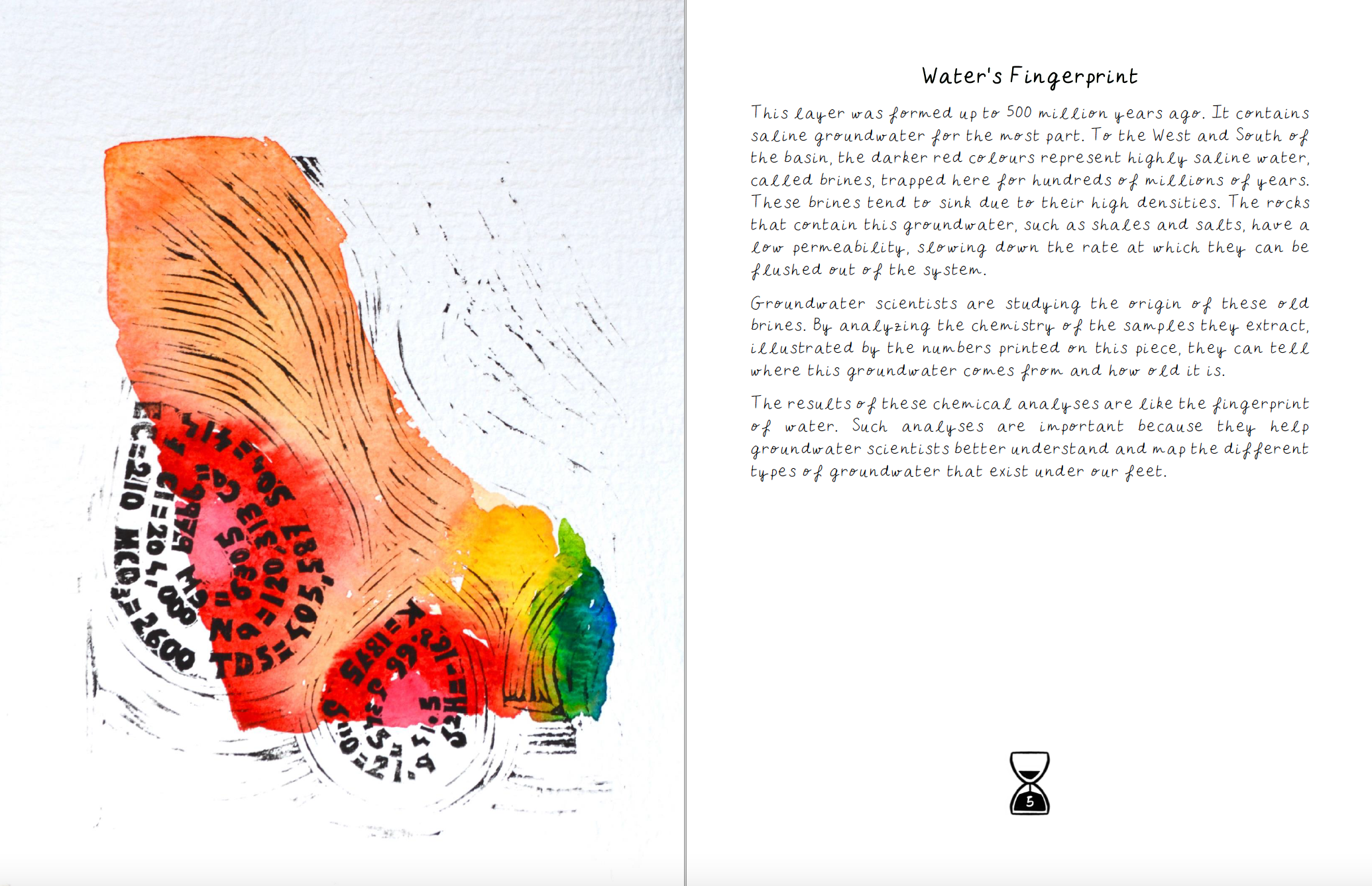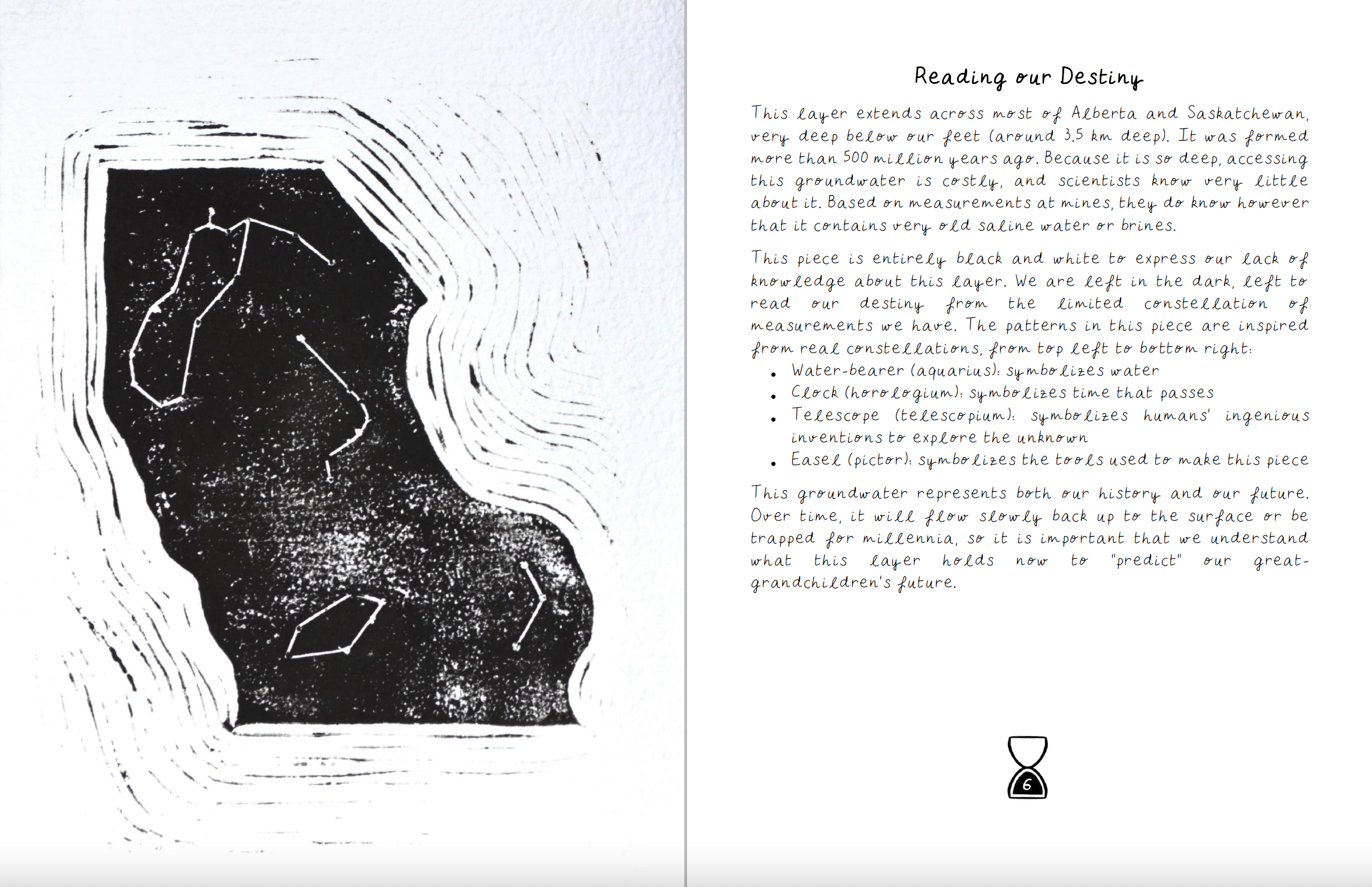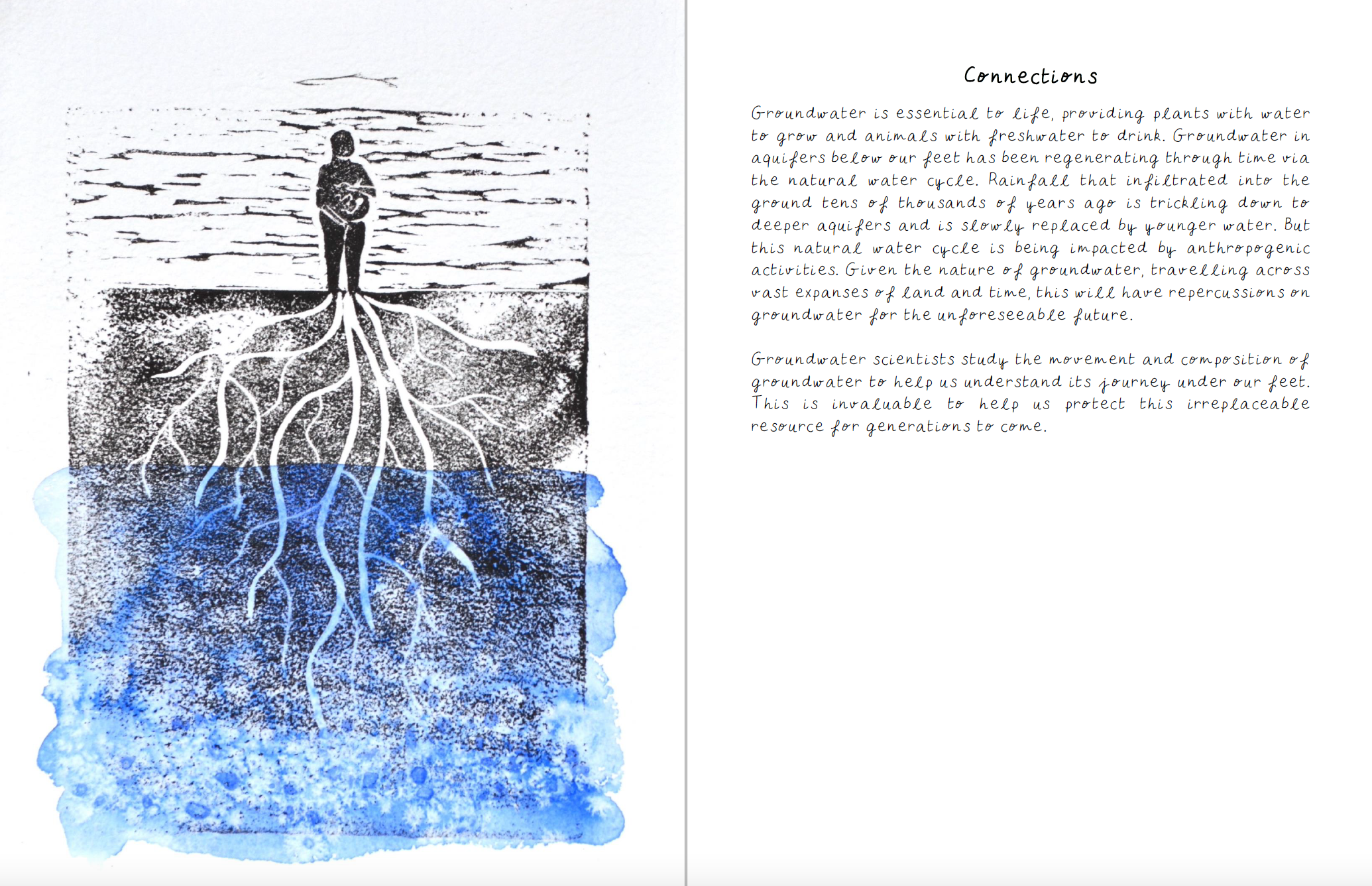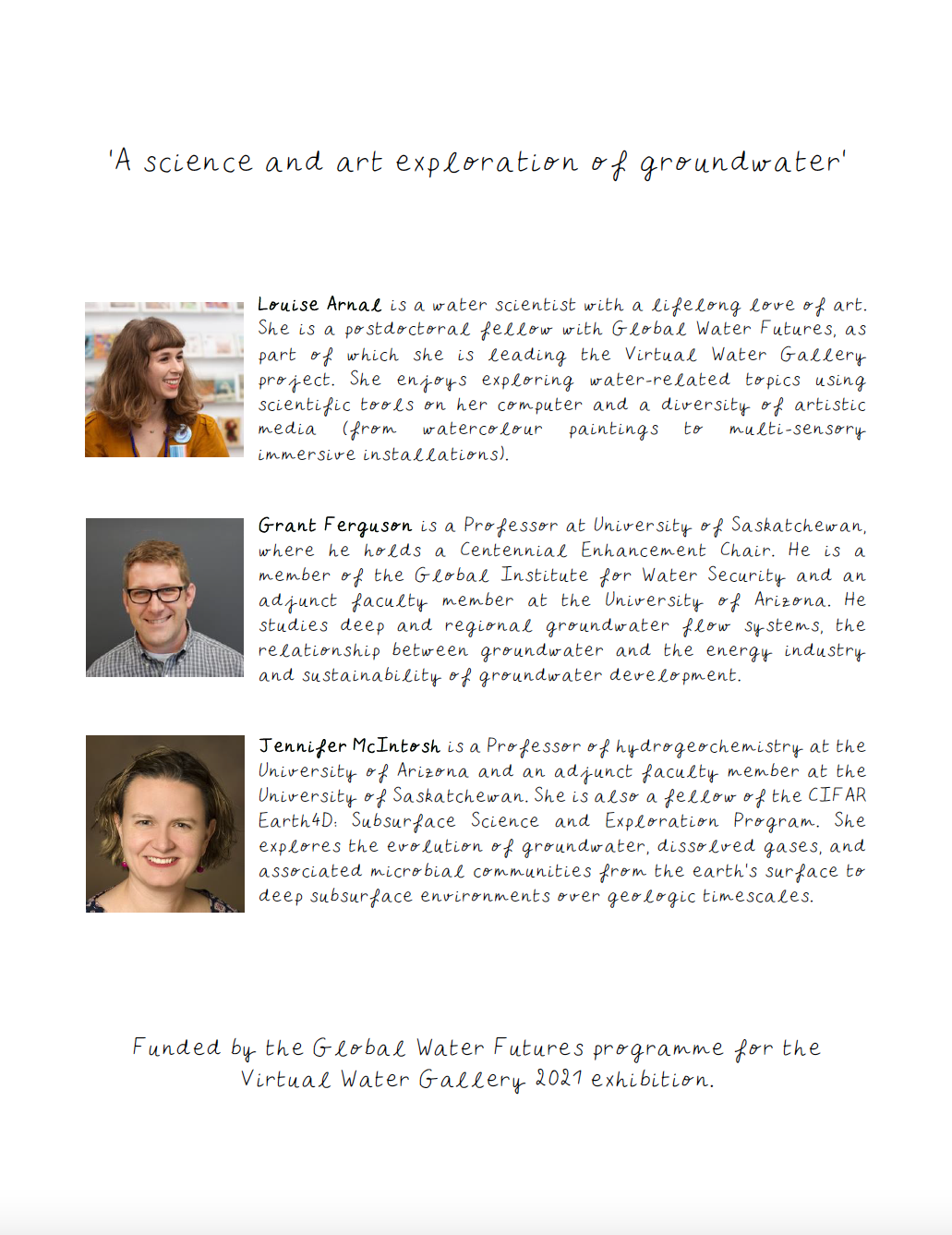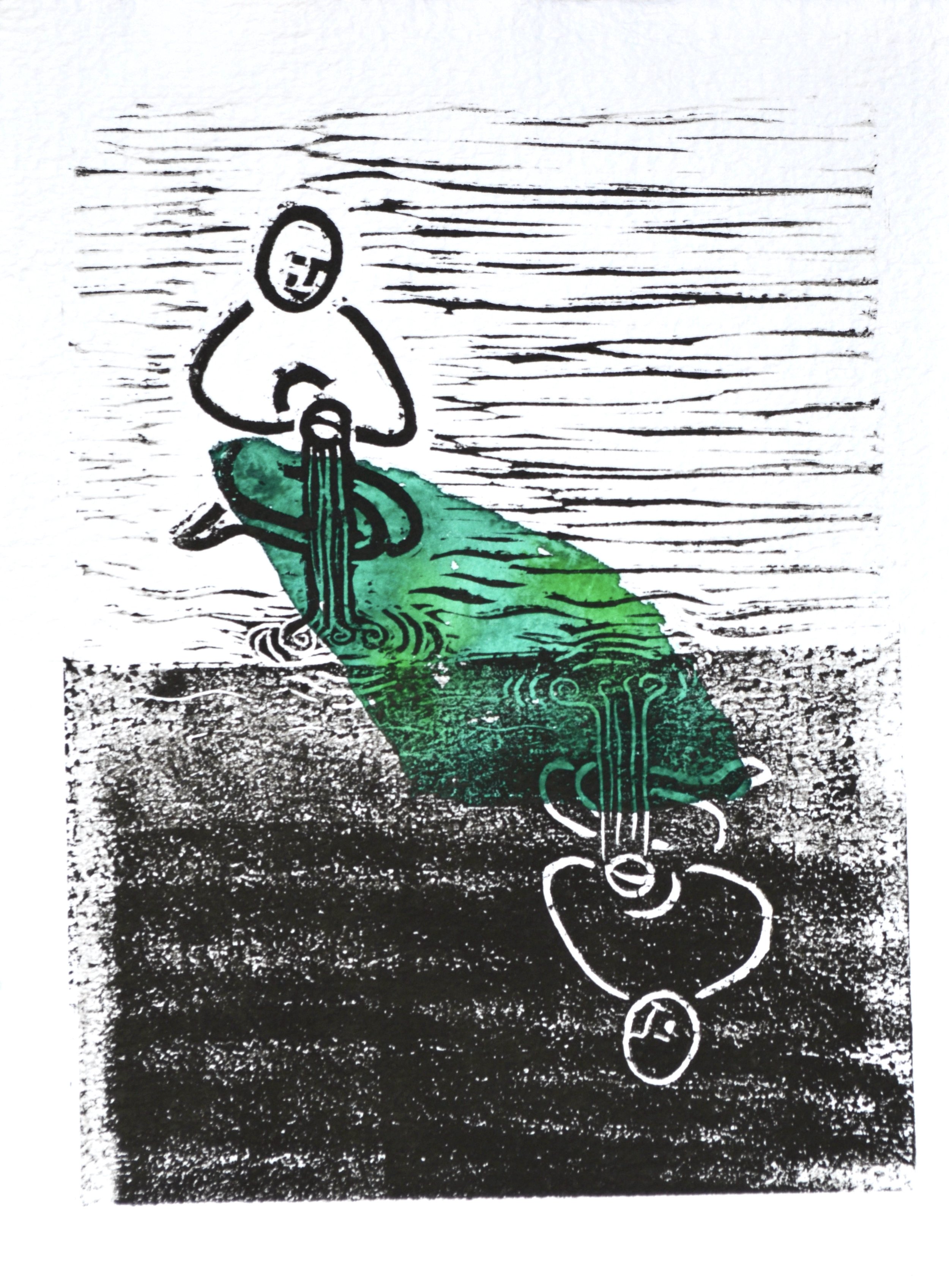
Deep Time
As a result of rich virtual exchanges, artist and water expert Louise Arnal, and water experts Grant Ferguson and Jennifer McIntosh co-created a book, offering a science and art exploration of groundwater and the related environmental challenges.
A water drop spends a large part of its life below our feet. It travels through a vast network of underground corridors, called aquifers, for up to tens of thousands of years. Groundwater is an important part of everyday life, providing drinking water to 1/3 of the population of Canada. This invaluable resource is under immense pressure, such as water contamination and freshwater depletion. These social and environmental challenges cover vast areas and affect families across several generations. Yet, the journey of water under our feet is still partly a mystery because we cannot see it with our own eyes, and measuring its movement is costly.
Deep Time is a book that combines linoprints and watercolour illustrations with scientific stories, taking you on a scientific and artistic journey through aquifers of the Western Canada Sedimentary Basin. You can view each individual illustration below.
Louise Arnal
Illustrations for book entitled ‘Deep Time’
Linoprints and watercolour on paper, each illustration is 7x10”
To purchase digital or paper prints of the book or of any individual illustration please contact the artist using this form.
A water drop spends an extensive part of its life underground, traveling through a labyrinth of aquifers (with residence times of up to tens of thousands of years or longer; Ferguson et al., 2020). Yet, its journey underground is still partly a mystery to humans because we cannot see it with our own eyes, and measuring/mapping the movements of water underground requires expensive methods (McIntosh et al., 2018). Groundwater features relatively rarely compared to other water-climate-related topics amongst public discussions and works of art. This is perhaps because we have a tendency to associate the ground with dark topics – e.g., hell is found below the ground in some religions and the ground is where many cultures bury their dead. As Robert Macfarlane puts it in his book entitled Underland: “height is celebrated but depth is despised. To be ‘uplifted’ is preferable to being ‘depressed’ or ‘pulled down’”. How ironic that groundwater is what brings life and colour to living things on the surface.
Approximately one third of the population of Canada relies on groundwater for domestic use, such as drinking and heating (according to numbers reported by ECCC). The social and environmental scientific challenges and impacts related to groundwater are manifold and span very large space and time horizons. Some of the very topical challenges tackled by the Global Water Futures project Old Meets New led by Grant Ferguson include:
- Water contamination
- Depleted aquifers
- Use of deep groundwater by oil/gas activities
- Data scarcity
These overlap with some of the freshwater management challenges highlighted by the wider public on the public consultation PlaceSpeak platform, towards the creation of the Canada Water Agency.
Behind the Exhibit: Deep Time
Artist Louise Arnal contacted water expert Grant Ferguson at the end of 2020 to learn more about groundwater. She was fascinated by the idea that you can measure certain qualities of groundwater to learn about the journey and story of this water. Since then, Grant, Jennifer McIntosh (who works closely with Grant) and Louise have had several inspiring virtual meetings, where Grant and Jen passed on their rich knowledge about the groundwater of the Western Canada Sedimentary Basin.
The creative process
“Through regular virtual meetings with Grant and Jen, I understood little by little the unique story of each of these layers. The maps Grant sent were also crucial in understanding how each of these layers are positioned in space. The challenge then was to translate these scientific stories into clear yet poetic visuals.” - Louise Arnal
As we talked about the many layers that make up the Western Canada Sedimentary Basin, the book format became an obvious choice. The book pages would stack up one above the other to represent the superimposed ground layers. Each page of this book (except for the cover and back-cover images) represents an important ground layer, from shallow to deeper layers of the basin. So with each turn of a page, the reader can dive deeper into the soil.
Each illustration is composed of:
a watercolour painting that represents a horizontal map of the layer’s salinity, representing groundwater quality, when the data was available,
a thought-provoking linoprint illustration that tells the socio-scientific story of that particular layer.
The watercolour paintings are hidden underneath the illustrations to symbolize the “hidden” nature of groundwater below our feet. The use of linocut, an early method used for printmaking, recalls headlines on a newspaper’s front page to instigate action. The layering in space and the unfolding of the story-like illustrations in time are meant to evoke the movement of groundwater in space, but also in time from generation to generation.
“As I was carving the linoleum blocks to create the linoprint designs, I felt like I was digging into the ground to uncover each layer’s unique story.” - Louise Arnal
“For the back-cover illustration, “Connections”, instead of using different colours to represent groundwater salinity, I chose to play with actual salt to give some texture to the watercolour.” - Louise Arnal
Reflections on the collaboration
This book was designed to make readers think about what they cannot see and hopefully start a few conversations about groundwater. While it’s specific to a particular place and time, it communicates groundwater-related challenges that are common to many places in the world and that span several generations.
Louise is a water scientist as well, but has discovered a lot more about water through this collaboration:
“I’m a hydrologist as well but my work focuses mainly on rivers - the water that we can see flow with our own eyes. Working on this piece about groundwater with Grant and Jen has been eye opening. It made me realize the sheer scales (both geographical and over time) of water movement from the atmosphere down to hundreds of kilometers below our feet! If you had asked me about a specific river before, I would have told you that it flows from mountains A to shore Z. But now I think about water differently - there is all this water under our feet that feeds into rivers and lakes and that we so easily dismiss.” - Louise Arnal
Grant noted that one of the problems with communicating groundwater issues to the public is that it is hidden from view:
"Groundwater is often the forgotten component of the hydrological cycle – out of sight and out of mind. Graphs and maps of falling water tables and contaminated groundwater don't seem to provoke the same emotional response that dry stream beds or contaminant spills at the ground surface do. The stories that Louise has been able to tell about groundwater through her art resonate in a much different way. Louise was able to translate the science that Jennifer and I do into pieces that convey the value, wonder and mystery of these hidden water resources." - Grant Ferguson
Louise Arnal is a water scientist with a lifelong love of art. She is a postdoctoral fellow with Global Water Futures, as part of which she is leading the Virtual Water Gallery project. She enjoys exploring water-related topics using scientific tools on her computer and a diversity of artistic media (from watercolour paintings to multi-sensory immersive installations). You can see some of Louise's science and art projects on her website and connect with her on Twitter and on Instagram.
Grant Ferguson is a Professor at University of Saskatchewan in the Department of Civil, Geological and Environmental Engineering and the School of Environment and Sustainability, where he holds a Centennial Enhancement Chair. He is a member of the Global Institute for Water Security and an adjunct faculty member at the University of Arizona. He studies deep and regional groundwater flow systems, the relationship between groundwater and the energy industry and sustainability of groundwater development.
Jennifer McIntosh is a Distinguished Scholar and Professor of hydrogeochemistry at the University of Arizona in the department of Hydrology and Atmospheric Sciences and adjunct faculty at the University of Saskatchewan. She is also a fellow of the CIFAR Earth4D: Subsurface Science and Exploration Program. She explores the evolution of groundwater, dissolved gases, and associated microbial communities from the earth’s surface to deep subsurface environments over geologic timescales using natural chemical and isotopic tracers.
Contact Us!
Want to share your comments, questions or perspectives on this gallery and the themes explored? Please Contact Us!
The Virtual Water Gallery team is committed to providing a safe, respectful, harassment-free, and accessible space for all. We do not tolerate harassment of any member of society.








